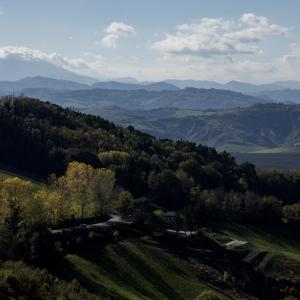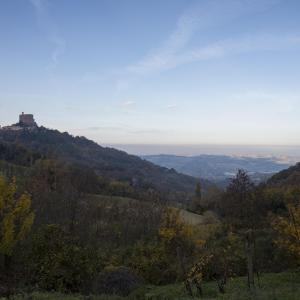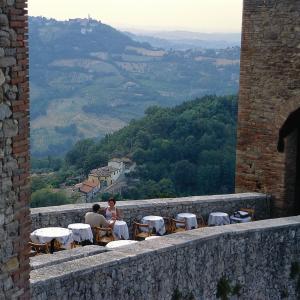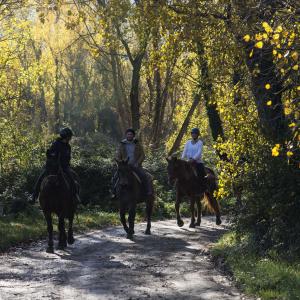Conca Valley
The source of the River Conca is a small anonymous spring on Mount Carpegna in the historic Montefeltro region in Le Marche; it flows into the sea in the Romagna region between Cattolica and Misano Adriatico.
In ancient times its waters must have often been ruinous, since Roman writers defined it “rapacious”: when in flood it covered wide stretches of ground and carried away everything in its path. It is still a seasonal torrential stream today, alternating periods of drought with impressive floods, and its rapacious nature is still evident at times. And yet the lands of this valley look so peaceful, all gentle rounded hills with villages on their summits.
But the warrior spirit can be felt here stet: many castles still border the lands of Urbino, whose powerful lords the Montefeltro family were a continual threat to the Malatestas (and vice versa). All this can be clearly read in the fortresses and towers, the fortified villages and small towns which often retain recognisable and at times intact mediaeval and Renaissance forms.
Things to know
The River Conca, known in ancient times by the name Crustumium, rises in Le Marche, at a height of about 1,400 metres, on Mount Carpegna. The river begins its course in the province of Pesaro and then enters the Malatesta Seignory, carving its way through the hills and widening out into a broad plain stretching as far as the beaches of the Adriatic, to enter the sea between Cattolica and Misano. The Seignory numbers nine towns and villages in the Conca Valley: Gemmano, Mondaino, Morciano, Montecolombo, Montefiore, Montegridolfo, Saludecio, San Clemente, San Giovanni in Marignano. The Conca valley is unusual in that it is a both gentle and wild at the same time; its distinguishing feature is a harmony between the activity of mankind and the working of nature; a harmony still tangible in the combination of historic settlements, agriculture, and wild natural areas.
The Conca valley is a region of beautiful hills reaching out towards the Apennines, always gentle, never harsh, where fields of corn alternate with vineyards and olive groves, occasional chestnut woods, and oak woods on the edges of meadows used for pastureland. The hills are often crowned with villages, stretched out along narrow ridges or perched on the top of jutting peaks. Visitors to the valley are often pleasantly surprised by the beauty of the countryside and by the views, where the sea is never out of sight and the hills and distant mountains are a constant backdrop.
The Conca valley is a region where the land itself still has a fundamental and decisive role to play in creating an environment of great beauty; other significant factors are the valley of the Marano, the third in importance in the Rimini area, and the Ventena valleys, Gemmano and Saludecio, small but of outstanding natural beauty. History too has played a crucial part in defining the shape and the life of the Conca valley, determining the alternating fortunes of the various towns and villages.
Fortresses and fortified villages are scattered throughout the region, guarding the perilous borders with the Duchy of Urbino, which made both its military might and its artistic and cultural influence felt in the surrounding territory. In these fortresses the Malatesta lords resided for much of the year; important meetings took place here, deciding the destiny of the Seignory. Some of the fortresses were more like royal palaces – Montefiore, for instance, where heirs to the House of Malatesta were born and where princes and Popes were received as guests; or Mondaino, where peace treaties were drawn up and signed. Works of art and of mankind mingle with masterpieces of nature, some of them most unusual, such as the Onferno Caves. In short, the Conca valley is a place filled with interesting towns and villages to explore, but it is above all landscape: beautiful scenery to admire and to enjoy.



